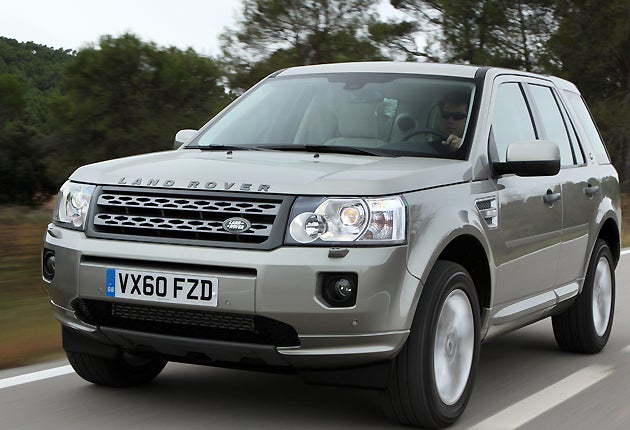Land Rover Freelander 2
Four minus two makes for a fuel-saving model that still performs off-road

Price: £TBA
Top speed: 112 mph
0-62 mph: 10.9 seconds
Consumption: 47.2 mpg
CO2 emissions: 158 g/km
Land Rover has introduced a series of revisions to the Freelander for the 2011 model year. The changes are less far-reaching than the mid-life updates that were carried out last year on the larger Discovery and Range Rover Sport models except in one respect; the Freelander will in future be available with front-wheel drive, making it the first mainstream Land Rover model to be offered with an alternative to four-wheel drive. That's one big surprise. The second is that the front-wheel drive Freelander performs rather well if you take it off-road.
The Freelander has always been an appealing product. The present second-generation model, introduced in 2006 retained the distinctive look of the 1996 original but combined this with much improved quality and technology. While the Freelander is much lighter and more car-like in construction than the company's bigger models, which makes it cheaper and more economical, it still retains most of the things that customers like about Land Rovers. That includes the raised “command” driving position and a high level of off-road ability. The Freelander is also very pleasant to drive on the road; the 2.2-litre power unit that has been the main engine option for the car since 2006 is very refined and free-revving for a diesel; its only drawback was that its fuel consumption and emissions weren't quite as good as those of some competitors.
Land Rover's first step towards tackling this issue was to introduce a stop-start system for the Freelander. Stop-start automatically switches off a car's engine when the driver selects neutral during, say, a long wait at traffic lights; as soon as first gear is selected, the engine is automatically restarted.
The second, more drastic step is the availability of the new front-wheel drive option. Even just a year or two ago, it would have been almost unthinkable for Land Rover, which has built its reputation on its cars' outstanding off-road performance to make such a move but the benefits in terms of fuel consumption and emissions have become impossible to ignore. The new 2WD Freelander, badged eD4, has a 2.2-litre diesel engine that turns out 150 horsepower, ten less than the pre-2011 models, but torque is increased by 20 Newton metres. The elimination of four-wheel drive saves about 75kg. The combined impact of these changes means that the eD4 now achieves combined cycle fuel consumption of 47.2 mpg and CO2 emissions of 158g/km, the lowest figure ever recorded by a Land Rover model and 11.7% better than the lowest figure previously achieved by a Freelander.
On the road, the eD4 feels very similar to other Freelander 2s; it is perhaps a touch more agile, probably because of that weight saving. The real surprise is that it gives a fairly good account of itself off the road as well. Land Rover may have removed the four-wheel drive powertrain from the eD4 but they've left in place most of the other things that make the Freelander a sturdy off-roader; it still shares good ground clearance, chunky tyres and many water-proofed or toughened-up components with its four-wheel drive sisters. It has an excellent braked towing weight of 2,000kg.
I had the chance to drive the eD4 on a fairly demanding circuit at Land Rover's Les Comes off-road centre in Spain. It was able to handle several obstacles that most owners would probably be reluctant to tackle even with four-wheel drive. These included wading deep water, ascending steep gradients with loose surfaces, dealing with high angles of departure and attack and soaking up a lot of punishment from wheel-swallowing potholes and big sharp rocks.
Land Rover's four-wheel drive systems have to a large extent de-skilled the activity of off-roading; in the 2WD eD4 some of the old skills and techniques have to be rediscovered and a couple of new ones learnt. The most important requirement is to maintain momentum as it is much harder to get going again in a 2WD car than one with 4WD if you get stuck. Modern traction control and four-channel ABS braking also help the eD4 when its off the tarmac. Apparently the ABS is almost as effective as Land Rover's Hill Descent Control and in the eD4, it can be appropriate to descend a steep incline using the brakes to hold the car back with the clutch pedal depressed, which is a modification of the traditional advice to maintain drive under such circumstances.
I also drove the same circuit in a four-wheel drive Freelander with automatic transmission which just cruised through many of the hairier spots where the eD4 had scrabbled for grip. Overall, though, the eD4 was still very impressive, even if it would probably be at a disadvantage in muddy or snowy conditions.
Other changes for 2011 include a more powerful 190 horsepower version of the 2.2 litre diesel for the most expensive Freelander models, badged SD4, and a variety of cosmetic tweaks aimed at keeping the interior and exterior styling fresh.
The Freelander won't be the only land Rover available with 2WD for very long. Early next year, it will be joined by the similarly-sized baby Range Rover, the Evoque, which will also be sold with a choice of 2WD and 4WD. We already know what the Evoque looks like; the latest Freelander is probably the best guide we have to how the Evoque might behave on and off the road. The signs are encouraging.
Join our commenting forum
Join thought-provoking conversations, follow other Independent readers and see their replies
Comments